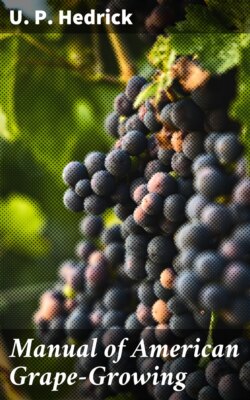Читать книгу Manual of American Grape-Growing - U. P. Hedrick - Страница 13
На сайте Литреса книга снята с продажи.
The Æstivalis or summer-grapes.
ОглавлениеThe South has another grape of remarkable horticultural possibilities. This is Vitis æstivalis (Fig. 4), the summer-grape or, to distinguish it from the Rotundifolias, the bunch-grape of southern forests. There are now a score or more well-known varieties of this species, the best known being Norton, which probably originated with Dr. D. N. Norton, Richmond, Virginia, in the early part of the nineteenth century. The berries of the true Æstivalis grapes are too small, too destitute of pulp and too tart to make good dessert fruits, but from them are made our best native red wines. Domestication of this species has been greatly retarded by a peculiarity of the species which hinders its propagation. Grapes are best propagated from cuttings, but this species is not easily reproduced by this means and the difficulty of securing good young vines has been a serious handicap in its culture.
There are two subspecies of Vitis æstivalis which promise much for American viticulture. Vitis æstivalis Bourquiniana, known only under cultivation and of very doubtful botanical standing, furnishes American viticulture several valuable varieties. Chief of these is the Delaware, the introduction of which sixty years ago from the town of Delaware, Ohio, raised the standard in quality of New World grapes to that of Old World. No European grape has a richer or more delicate flavor, or a more pleasing aroma, than Delaware. While a northern grape, it can be grown in the South, and thrives under so many different climatic and soil conditions and under all is so fruitful, that, next to the Concord, it is the most popular American grape for garden and vineyard. Without question, however, Delaware contains a trace of European blood.
Fig. 4. A shoot of Vitis æstivalis.
Another offshoot of this subspecies is Herbemont, which, in the South, holds the same rank that Concord holds in the North. The variety is grown only south of the Ohio, and in this great region it is esteemed by all for a dessert grape and for its light red wine. It is one of the few American varieties which finds favor in France, being cultivated in southwest France as a wine-grape. Its history goes back to a colony of French Huguenots in Georgia before the Revolutionary War. Very similar to Herbemont is Lenoir, also with a history tracing back to the French in the Carolinas or Georgia in the eighteenth century.
The other subspecies of Vitis æstivalis is Vitis æstivalis Lincecumii, the post-oak grape of Texas and of the southern part of the Mississippi Valley. Recently this wild grape has been brought under domestication, and from it has been bred a number of most promising varieties for hot and dry regions.
